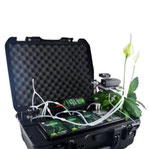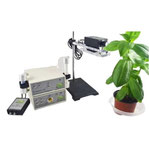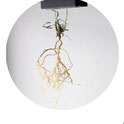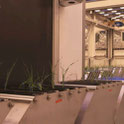Shoot Phenotyping and Leaf Physiology
Plant Phenotyping & Leaf Physiology. Plant phenotyping and gas exchange measurements are critical for understanding plant growth, development, and response to environmental conditions. Imaging techniques realized by phenotyping platforms enable non-destructive, high-throughput analysis of shoot and root traits. This provides valuable insights into plant architecture, stress tolerance and yield potential, and facilitates breeding for improved varieties. Modular and affordable CO2 analyser systems determine plant photosynthesis and respiration in situ and under laboratory conditions.
Automated, Rotational Shoot Phenotyping

Shoot Phenobox, a versatile plant phenotyping system for the standardized, HT assessment of shoot traits in laboratories and greenhouses based on open hardware and open source principles. The phenotyping system is suitable for medium-sized plants and consists of two main components: the 'Shoot PhenoBox', an imaging chamber that autonomously captures and processes plant shoot images from different perspectives, and the 'PhenoPipe', an open source analytical framework for sample management and image analysis. Vienna Scientific supports researchers to realize open hardware designs. For fully automated imaging of (larger) plants growing in rhizoboxes (roots & shoots) see the Rhizobox Imaging Platform. Read below for more details on the application potential of image-based plant phenotyping.
Plant Physiology
Plant photosynthesis, respiration, transpiration, and stress can be cost-effectively measured as CO2, O2, H2O gas exchange with Q-Box Packages, or with imaging devices measuring optical parameters related to photosynthesis and plant vitality / stress (chlorophyll fluorescence, OJIP, Fv/Fm, pathogen infections, etc.).
Q-CO650 Plant CO2 Analyser System, designed to measure photosynthesis, respiration and transpiration in leaves when placed in the included, temperature controlled flow-through leaf chamber. The package can be used in the laboratory or in the field and is modular - allowing for future expansion / modification.
Q-FL23 CO2 Suspension Analysis Package, measures the CO2 exchange of algae, bacteria or fungal suspensions in the headspace of a transparent cuvette.
BLT-PlantView 100 Imaging Chamber - Laboratory, high resolution fluorescence / luminescence top imaging in a dark cabinet equipped with adjustable light sources, cooling. Lateral Imaging module, extended excitation light and filters optional.
BLT-PlantView 230F Chlorophyll Fluorescence Imager, high resolution, high speed imaging of multiple fluorescence parameters for various disciplines of plant sciences from breeding, post harvest technology to stress physiology.
Teaching & Learning Package - Photosynthesis, versatile hands-on teaching instrumentation for schools and universities. Effective instrument for use in classes.
Application Potential of Shoot Phenotyping & Imaging Technologies
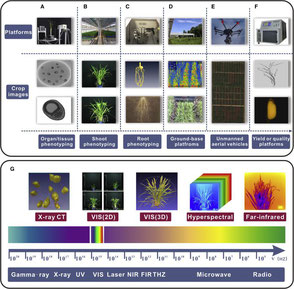
The term "phenotype," derived from the Greek phainein and typos (meaning to show or type), was characterized by Wilhelm Johannsen in 1911: "All types of organisms can be distinguished by direct inspection or by finer methods of measurement or description" (Johannsen, 1911).
Plant shoot phenotyping plays a vital role in plant research and agriculture by providing valuable insights into plant growth, development and response to environmental conditions. Understanding the phenotypic characteristics of plant shoots is critical for improving crop productivity, stress tolerance, and developing sustainable agricultural practices. Here, we briefly review the importance of plant shoot phenotyping, its application potential, and some of the different imaging approaches used in plant phenotyping.
- Plant shoot phenotyping is important for several reasons. First, it allows researchers to study the genetic and environmental factors that influence plant growth and development. ... Continue reading
-
By quantifying shoot traits such as architecture, leaf area, biomass accumulation, and branching patterns (over time), scientists can gain a deeper understanding of plant (eco-)physiology and identify key factors that affect crop productivity. Second, shoot phenotyping provides valuable insights into stress responses and tolerance mechanisms in plants. With climate change and increasing environmental challenges, it is critical to develop (crop) varieties that can withstand biotic and abiotic stresses. By studying shoot phenotypes under different stress levels, researchers can identify traits associated with stress tolerance and use this information to breed / select resilient (crop) varieties. In addition, phenotyping facilitates precision agriculture and optimized resource management. By analyzing shoot traits such as leaf chlorophyll content or water use efficiency, growers can make informed decisions about irrigation, fertilization and (insect) pest management. This targeted approach ensures efficient resource allocation, reduces environmental impact and improves overall crop yield and quality. The application potential of plant shoot phenotyping is therefore vast. It ranges from basic research in plant biology to practical applications in crop improvement and agricultural management. Phenotyping enables the identification of key genes and regulatory pathways involved in shoot development and response to environmental cues. This knowledge can be used to manipulate plant traits for desired outcomes, such as increased yield, nutrient use efficiency or stress tolerance. In crop breeding, shoot phenotyping plays a critical role in the selection and development of superior varieties. By accurately assessing shoot traits in large populations, breeders can identify plants with desirable traits and use them as parent lines for crosses. This accelerates the breeding process and enables the development of new crop varieties with improved traits such as disease resistance, drought tolerance or optimized architecture for high-density planting.
Imaging approaches have revolutionized plant phenotyping by providing non-destructive, high-throughput, and accurate measurements. Several imaging techniques are currently used in shoot phenotyping. For example, RGB imaging, using standard digital cameras, captures color information and allows analysis of shoot architecture, leaf area, and color-based stress indicators. It is an inexpensive and widely used approach. Infrared thermography measures the temperature of plant shoots, providing insight into stress responses and water status. By detecting temperature changes, researchers can identify areas of stress or transpiration patterns, helping to optimize irrigation strategies and detect early signs of disease or pest infestation. Increasingly affordable multi- or hyperspectral imaging captures detailed information about the reflectance of plant tissues at different wavebands. This technique allows the quantification of biochemical properties such as chlorophyll content, nitrogen concentration or disease symptoms. By analyzing spectral signatures, researchers can assess plant health, nutrient status, and stress responses. Finally, 3D imaging techniques, such as laser scanning or rotational imaging with RGB cameras (as in the Shoot Phenobox approach, but also the Root Analyzer platform), provide precise measurements of shoot (or root) architecture, biomass distribution, and branching patterns. This information is valuable for studying plant growth patterns, optimizing plant spacing, and assessing the efficiency of light interception in dense stands.
In summary, shoot phenotyping is essential for understanding plant growth, development, and stress responses and has significant implications for crop improvement and agricultural management. Imaging techniques have revolutionized shoot and root phenotyping by providing non-destructive, high-throughput and accurate measurements of traits. The application potential of phenotyping ranges from basic research to practical applications in crop breeding, precision agriculture and resource management, ultimately contributing to sustainable and cost-effective management practices.
| References | Shoot Phenotyping | OPEN |
|
||
For rotational RGB imaging of root crowns and whole root systems, analogous to the rotational RGB shoot phenotyping system above, consider the LK-1200 Benchtop Root Analyser.
For combined imaging of roots in rhizoboxes and shoots, see the fully automated, standardized rhizobox imaging platform.
Interested in Soil Respiration Measurements? The Q-Box Soil Respiration Package SR1LP offers a complete solution for the field and laboratory.

